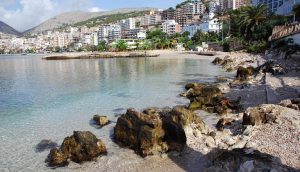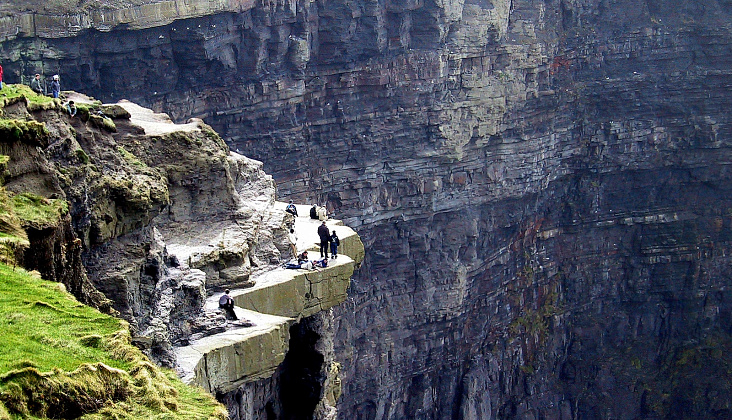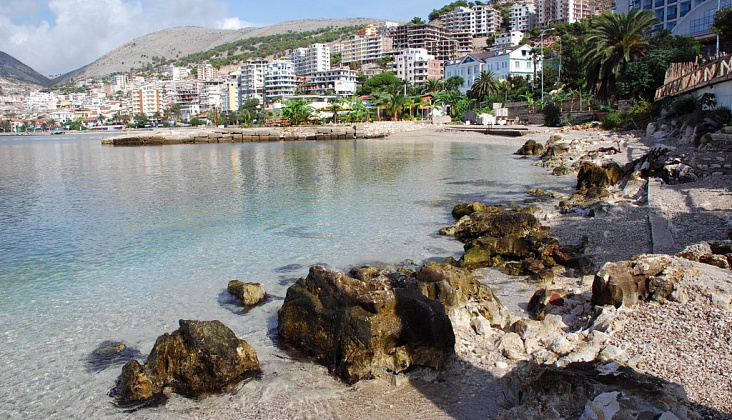Albania – a state in south-eastern Europe
 SHOPPING
SHOPPING
As a souvenir from Albania, you can bring a copy of one of the ancient works that are sold everywhere, as well as products of local artisans.
Bargaining is always and everywhere. In the markets and bazaars with a certain skill, you can bring down the price by 20-30%.
WHERE TO STAY
In recent years (since 2006), a large number of hotels and tourist complexes, both by local and foreign investors, have been restored and built in Albania. There are hotels of all categories in the country, where the level of service fully complies with European standards.
Prices for accommodation in hotels in Albania are slightly lower than in neighboring Montenegro.
SEA AND BEACHES
On the Adriatic coast of Albania, the beaches are mostly sandy, but there are pebbles. The main beaches are Durres, Lying, Velipoja, Divyaka, Golemi.
The Ionian Sea is famous for its crystal water and tiny beaches, much of which are pebbly or stony-pebbly. The most famous beaches of the Ionian Sea are Cheparoi, Yala, Dermi, Guimara, Borsi, Xamil and Saranda.
STORY
Albania was already inhabited during the Upper Paleolithic. In the Neolithic, Albania was at the turn of several large archaeological cultures, mainly associated with the origin of Sesklo and Starchevo-Krish culture. The late descendants of the Neolithic population (Malik culture) were assimilated by native Indo-European languages, as a result of which the Illyrians were formed.
Antique period
In the ancient period, the territory of modern Albania was inhabited by the ancestors of modern Albanians – Illyrian tribes, mainly the Tavlantia and Dardan tribes. Its southern part was part of Epirus. The central part, with the Greek cities of Apollonia and Epidamn, renamed the Romans Dyrrachios (now Durres), since the time of Philip II and Alexander the Great sporadically was part of the state of Macedonia and with its annexation to Rome in 146 BC. e. – became part of the same Roman province. The northern part, with the cities of Skodra (now Shkodra) and Liss, from the II century BC. e. became part of the Roman province of Dalmatia.
Dyrrahiy was an important center, since it was located in a narrow part of the Adriatic Sea and from there it was usually shipped from the Balkans to Italy, and vice versa; there began the strategically important Emilieva Road, which led across The Peninsula to Thessaloniki and further through Byzantium to Asia.
Middle Ages
When the Roman Empire was divided, the main part of the country became part of Byzantium, Dalmatia was part of the Western Roman Empire. It was invaded by the Huns and the Huns (end of the 4th-5th centuries), from the end of the 6th century – by the Slavic tribes.
Part of the territory for about a century was part of the so-called First Bulgarian Kingdom. After the capture of Constantinople by the crusaders, parts of the territory of modern Albania were alternately dominated by Venetians, the Empire of Epirus, the Kingdom of Neapolitan, and the Serbian Kingdom. In the middle of the XIV century, the entire territory of Albania was conquered by the Serbian king Stefan Dusan.
Scanderbeg Wars
In 1381, the Turks penetrated into the territory of Albania and supported in the tribal war the clan of Topi against the clan of Balsha. Albania has become a field of conflict of interests between the Venetians and the Turks. The Turks called the Albanians arnauts. In 1385 the Serbian and Albanian princes were defeated at the Battle of Savra.
In the middle of the 15th century, the national hero Skanderbeg resisted the Turks.
As part of the Ottoman Empire (1468-1912)
By the end of 1571 the Turks completely oust the Venetians from the territory of Albania. The mountainous north of Albania has retained a certain autonomy. The power there belonged to the councils of the elders led by the Bayraktara, the Guardians of the Banner. Islam is gradually spreading in Albania.
Ottoman rule remained until the beginning of the 20th century, when, during the First Balkan War, the territory of Albania was occupied by the troops of Montenegro, Serbia and Greece, and Turkey was defeated in the war and Albania was threatened with the division between rival powers.
As part of Turkey, Albania had sufficient autonomy. The lands inhabited by the Albanians in 1835 were divided into the villages of Yanin and Roumelia, headed by officials from Constantinople. Later, in 1846, pashalyks were created in Monastir (until 1877) and Uskiba (until 1863). After 1865, Istanbul re-divided Albanian lands between the provinces of Ishkodra (Shkoder), Ioannina (from 1867), Bitola (Monastir) and Kosovo (from 1877).
After the overthrow of Sultan Abdul-Hamid II in July 1908, Albanian schools appeared, newspapers and political clubs appeared, especially in the south of the country. In November 1908, a national congress was held in Monastir (Bitol), which discussed the issue of national autonomy and a single Albanian alphabet based on the Latin alphabet. In an effort to expand control of the mountaineers, the Young Turks adopted the so-called. the gang law (1909); it was forbidden to carry a weapon, punishment was introduced with sticks, etc.




